
The shark is a moth of the family Noctuidae. The species was first described by Carl Linnaeus in his landmark 1758 10th edition of Systema Naturae.

Cucullia is a genus of moths of the family Noctuidae. The genus was erected by Franz von Paula Schrank in 1802.

Cucullia lactucae, the lettuce shark, is a moth of the family Noctuidae. The species was first described by Michael Denis and Ignaz Schiffermüller in 1775. It is found in most of Europe, Turkey, the Caucasus and east across the Palearctic to the Altai mountains. In the Alps it rises to 1,800 metres (5,900 ft). It is found mainly in barren places, on weeds and debris and scree corridors on slopes, shrubby edges and in vineyards, gardens and parks.

Cucullia syrtana is a moth of the family Noctuidae first described by Paul Mabille in 1888. It is widely distributed in the desert and semi desert zone from the western Sahara and Morocco to Egypt, the Arabian Peninsula, Iraq and Iran. It has also been recorded on Malta and in Greece.

Cucullia argentina is a moth of the family Noctuidae. It is found from central Turkey throughout the Caucasus, Iraq, Iran, Turkmenistan, southern Russia, Kazakhstan and Afghanistan to Mongolia.

Cucullia santolinae is a moth of the family Noctuidae. It is found in southern Europe, northern Africa, Turkey, the Caucasus region and Israel.

Cucullia calendulae is a moth of the family Noctuidae. It is widespread in all parts of the Mediterranean Basin, from northern Africa to Saudi Arabia, Lebanon, Jordan, Israel, Transcaucasus, Turkmenistan, Iran and Afghanistan.
Cucullia santonici is a moth of the family Noctuidae. It was traditionally found from southern Europe through parts of Near East and Middle East to China.

Cucullia boryphora is a moth of the family Noctuidae first described by Gotthelf Fischer von Waldheim in 1840. It is found in the semi-arid and xeromountain areas of the Near East and Middle East, from the European part of southern Russia to Turkestan, the western Himalayas, Afghanistan, Iran, Saudi Arabia and United Arab Emirates.
Cucullia improba is a moth of the family Noctuidae first described by Hugo Theodor Christoph in 1885. It is found in the south-eastern Caucasus, Turkmenistan, Uzbekistan, Iran, Afghanistan, Turkey, Jordan and Israel.
Cucullia macara is a moth of the family Noctuidae first described by Hans Rebel in 1948. It has been recorded from North Africa the Levant and the Arabian Peninsula.

Shargacucullia lychnitis, the striped lychnis is a moth of the family Noctuidae. It is found throughout most parts of Europe the Near East and Middle East.

Cucullia absinthii, the wormwood, is a moth of the family Noctuidae. The species was first described by Carl Linnaeus in 1761. It is found from Europe to the Caucasus, Turkey, northern Iran, western Siberia, the Altai mountains, Tien-Shan and Tarbagatai.
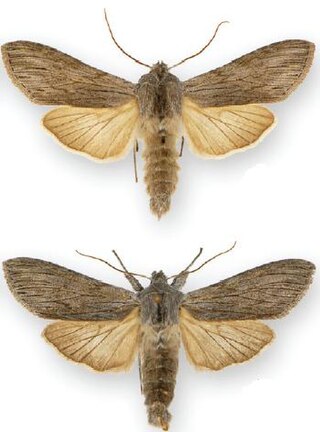
Cucullia intermedia, the dusky hooded owlet, intermediate cucullia, goldenrod cutworm or intermediate hooded owlet, is a moth of the family Noctuidae. The species was first described by Adolph Speyer in 1870. It is found from coast to coast across southern Canada and the northern United States, south in the west to California and to Pennsylvania in the east. In the Rocky Mountains it is found south to the White Mountains in east-central Arizona and occurs commonly in Utah, Colorado and north-eastern Nevada.
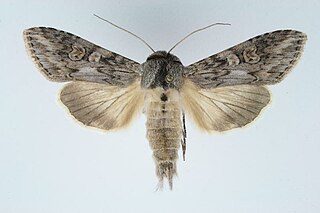
Cucullia artemisiae, or scarce wormwood, is a moth of the family Noctuidae. The species was first described by Johann Siegfried Hufnagel in 1766. It is found from central and southern Europe to Turkey and across the Palearctic to western Siberia, Central Asia, Manchuria, the Korean Peninsula and Japan.

Shargacucullia prenanthis, the false water betony, is a moth of the family Noctuidae. It is found from south-eastern France, through the Alps and bordering mountains east to Romania and Bulgaria. It is also found in Anatolia and Lebanon.

Cucullia xeranthemi is a species of moth of the family Noctuidae. In southern Europe, it is found locally from northern Spain, Italy and southern France to the Balkans. In the east, it is found from Lower Austria and Hungary to southern Russia and western Siberia.
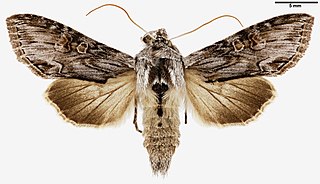
Cucullia gnaphalii, the cudweed, is a moth of the family Noctuidae. It is found from most of Europe to Turkey, Transcaucasia, Mongolia and Sayan.
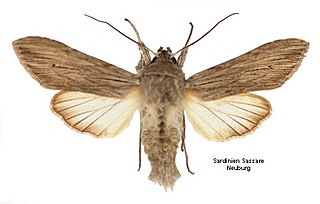
Cucullia tanaceti is a moth of the family Noctuidae. The species was first described by Michael Denis and Ignaz Schiffermüller in 1775.
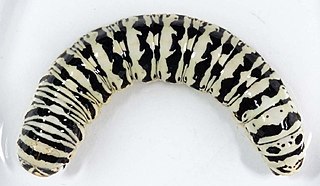
Cucullia speyeri, common names Speyer's paint, Speyer's cucullia or Speyer's hooded owlet moth, is a moth found in North America. It is found from Alberta and Montana to the Atlantic coast from New Hampshire to Virginia. It was described by Joseph Albert Lintner in 1874. In the US state of Connecticut, it is listed as a species of special concern and is believed to be extirpated. The habitat consists of open meadows, dry grasslands and native prairies.


















